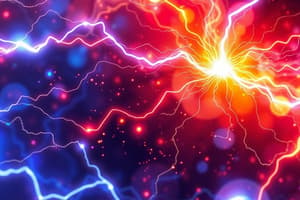Podcast
Questions and Answers
What does Ohm's Law describe?
What does Ohm's Law describe?
- The relationship between power, energy, and time
- The relationship between frequency, wavelength, and amplitude
- The relationship between voltage, current, and resistance (correct)
- The relationship between velocity, acceleration, and force
In Ohm's Law formula V = I * R, what does V represent?
In Ohm's Law formula V = I * R, what does V represent?
- Voltage (correct)
- Volume
- Variation
- Velocity
What is Kirchhoff's Current Law (KCL) about?
What is Kirchhoff's Current Law (KCL) about?
- The total current entering a junction equals the total current leaving the junction (correct)
- The total current in a circuit equals the total voltage drop
- The total resistance in a circuit is equal to the total voltage
- The total voltage entering a junction equals the total voltage leaving the junction
According to Kirchhoff's Voltage Law (KVL), what is the relationship between voltage drops and rises in an electric circuit?
According to Kirchhoff's Voltage Law (KVL), what is the relationship between voltage drops and rises in an electric circuit?
What fundamental concept is essential to understanding electrical systems?
What fundamental concept is essential to understanding electrical systems?
Which unit is used to measure resistance in an electric circuit?
Which unit is used to measure resistance in an electric circuit?
What is the unit used to measure resistance?
What is the unit used to measure resistance?
Which type of current is described as the flow of positive charge?
Which type of current is described as the flow of positive charge?
What is the mathematical relationship between current, voltage, and resistance called?
What is the mathematical relationship between current, voltage, and resistance called?
Which type of circuit has a fluctuating flow of electric charge that reverses direction periodically?
Which type of circuit has a fluctuating flow of electric charge that reverses direction periodically?
In terms of current flow, what is the more widely used description given in present-day engineering?
In terms of current flow, what is the more widely used description given in present-day engineering?
What fundamental physical phenomenon forms the basis of electrical engineering?
What fundamental physical phenomenon forms the basis of electrical engineering?
Study Notes
Electric Current: A Foundational Concept in Electrical Engineering
Electric current is the flow of charged particles, primarily electrons, through an electrical conductor. This fundamental concept, essential to understanding electrical systems, underpins the operation of circuits, devices, and power transmission. In this exploration, we'll delve into the mathematical relationships and physical principles that govern electric current, beginning with Ohm's Law, moving onto Kirchhoff's Laws, and concluding with a discussion on circuit components and types of current.
Ohm's Law
Ohm's Law, named after German physicist Georg Ohm, describes the relationship between voltage, current, and resistance in a circuit. The formula is:
[V = I \times R]
where (V) is the voltage (measured in volts, V), (I) is the current (measured in amperes, A), and (R) is the resistance (measured in ohms, Ω). Ohm's Law states that the current through a conductor between two points is directly proportional to the voltage across the two points.
Kirchhoff's Laws
Kirchhoff's Laws, formulated by German physicist Gustav Kirchhoff, are two principles that govern the behavior of electric circuits.
- Kirchhoff's Current Law (KCL): The total current entering a junction is equal to the total current leaving the junction.
- Kirchhoff's Voltage Law (KVL): The sum of the voltage drops along a closed loop in an electric circuit is equal to the sum of the voltage rises.
These laws enable us to analyze and solve circuits by ensuring current conservation and voltage closure.
Electric Circuits
An electric circuit is a closed path, or loop, in which charge flows through various components. These components can include conductors, resistors, capacitors, inductors, and voltage and current sources. Electric circuits are classified into two main types:
- DC (Direct Current): A constant, unidirectional flow of electric charge. Batteries and DC power supplies are common sources of DC current.
- AC (Alternating Current): A fluctuating flow of electric charge that reverses direction periodically. Household electricity is an example of AC current.
Resistance
Resistance is a property of materials that oppose the flow of electric current. The mathematical relationship between current, voltage, and resistance is described by Ohm's Law. Resistance is measured in ohms (Ω), a unit named after Georg Ohm.
Types of Current
There are two primary types of current:
- Conventional Current: The flow of positive charge, which is actually the movement of negatively charged electrons in the opposite direction. This description is more common in present-day engineering, as it is simpler and more consistent, as electrons flow from negative to positive potential.
- Electron Current: The actual flow of negatively charged electrons in a conductor. This description is more accurate but less common due to its complexity.
While conventional current is more widely used, it's crucial to understand that the fundamental physical phenomenon is the flow of electrons.
Electric current, coupled with Ohm's Law and Kirchhoff's Laws, forms the foundation of electrical engineering and provides a framework for understanding and designing circuits, devices, and power systems. By delving into these concepts, you'll acquire the knowledge necessary to navigate the fascinating world of electricity.
Studying That Suits You
Use AI to generate personalized quizzes and flashcards to suit your learning preferences.
Description
Test your knowledge on electric current, Ohm's Law, Kirchhoff's Laws, types of electric circuits, and the relationship between voltage, current, and resistance. Explore the concepts of conventional and electron current, resistance, and the foundational principles in electrical engineering.




